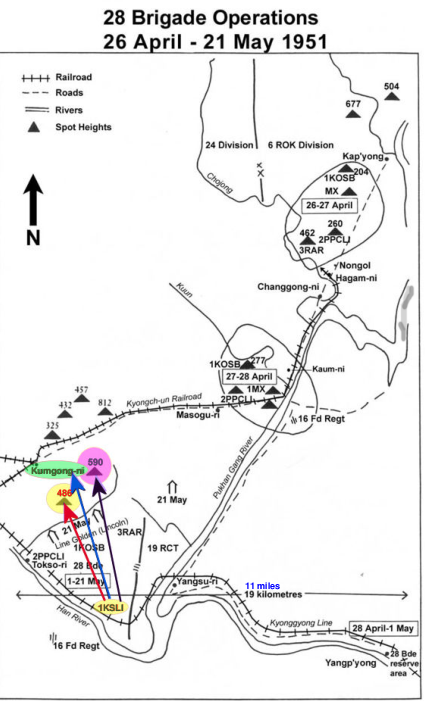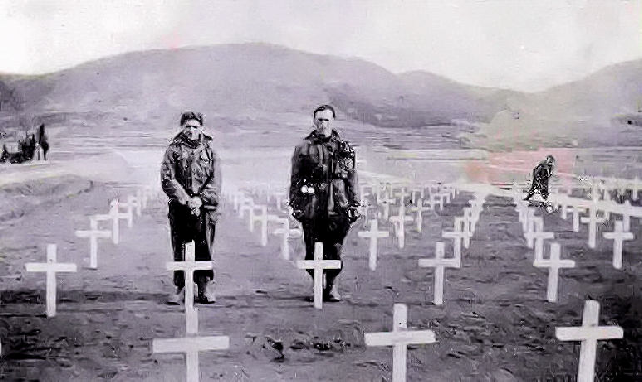


KOREA 1950 -1951
Pusan Military Cemetery circa August 1951
Two comrades pay their respects to L/Cpls. Yapp and Hanlon of 1st bn KSLI killed in action 1951.
In these pages we are trying to give a pictorial view of the "Forgotten War" 1950-1953.
This war was a terrible conflict and I fear that in some stages was very poorly managed. The determining factor of this conflict was the deaths and maiming of servicemen and civilians causing so much heartache and grief to so many families and their loved ones. I can speak from first hand experience my father was killed in action in the conflict on the 20th May 1951, I was 6 years old.
A short brief on the Korean War
by Bill Griffiths.
[additional annotations by CY Webmaster]
I joined the KSLI on 27th May 1946 at Copthorne Barracks Shrewsbury. I served with the Battalion in London when we were engaged on public duties carrying out the guarding of Buckingham Palace.
The Regiment was posted from there to Hong Kong and were employed as part of the Garrison force on the borders between Kowloon and mainland China.
From there we were sent to Korea in April 1951 to join the United Nations forces to take part in the Korean War. The Battalion fought courageously and were awarded Battle Honours for the battle of Kowang Sang hill 355, and the battle for hill 227.
Kowang Sang hill 355, and the battle for hill 227

Battle Map UN Commonwealth Brigade May 16th - 20th 1951
The Korean war was a bloody war which lasted for three years at the start of which the North Korean army first invaded South Korea and easily destroyed the South's resistance and took the Capital City Seoul. This gave rise to the intervention of the United Nations. The U.S. ground, air and Naval support being involved under the command of General Macarthur, and the land forces under the command of Lt General Walker
The North Koreans renewed their attack in July and pushed the U.S. and Korean forces way down to the South near to the Port of Pusan.
It had only taken them about three months to advance almost four hundred miles, destroying hundreds of towns and villages, during which there was a large loss of life, both military and civilian.
In the September the U.S. carried out an assault at Inchon to the West causing the North to retreat rapidly fearing being cut off at the border, the 38th parallel.
By October the U.S. and South Koreans being joined by the first British forces pushed their way back up to the North and took the Capital Pyongyang, then pushed on up towards the Yalu river [Amrok in Korea] which formed the border with China.
At this point Communist China intervened with over a million ground troops, at least two armoured divisions and a mechanised division with an estimated 520 tanks.
This intervention caused a split in the U.N. forces and a forced fighting retreat.
This attack was so strong and severe that U.N. troops had to be evacuated by sea from Hungnam and Wonsan.
By December the Chinese had moved back down South and by January had captured the Capital Seoul for the second time.
By February 1951, the retreating forces now joined by the British 27th and 29th Brigades managed to stabilise the situation and move forward again to retake Seoul and move further forward to hold a firm position north of the river Imjin, this position being held until the armistice in July 1953.
During this terrible war it is estimated that:
One million South Korean civilians were killed.
580 thousand United Nations and South Korean Troops killed, wounded or missing.
One million, six hundred thousand Communist troops killed, wounded or missing .
Several million South Korean civilians made homeless.
The Kings Shropshire Light Infantry returned to the UK in October 1952 having spent seventeen months in Korea. A memorial service was held at the United Nations Cemetery in Pusan on 14th September to honour the sixty two members of the Regiment who had given their lives during that bloody war.
THAT WAR SHOULD NOT BE FORGOTTEN.
Bill Griffiths
© Bill Griffiths 2006-2022

| About us |
| Contact us |
| our policy |
| Viewing Notes |
| Acknowledgements |
| Yapp family |
| james Yapps Cockney history |
| William and Eliza |
| Hannah and Mathew |
| James William Yapp |
| Mathew and Alice |
| Aussie connection |
| Family not forgotten |
| Origination 1 |
| Origination 2 |
| Origination 3 |
| KSLI 1951 |
| KSLI journal |
| Journal pt.1 |
| Journal pt.2 |
| Bill Griffiths |
| LCpl Hanlon |
| Bob_West |
| KSLI Roll of Honour |
| News Clips |
| Military Career |
| George Yapp KIA Korea |
| George service pictures |
| Communications |
| Georges Letters 1 |
| Georges letters 2 |
| Last letters home |
| Georges Awards |
| UN Memorial Cemetery Korea |
| Georges Story |
| Exchange rates |
| World Time |
| Speed Tester |